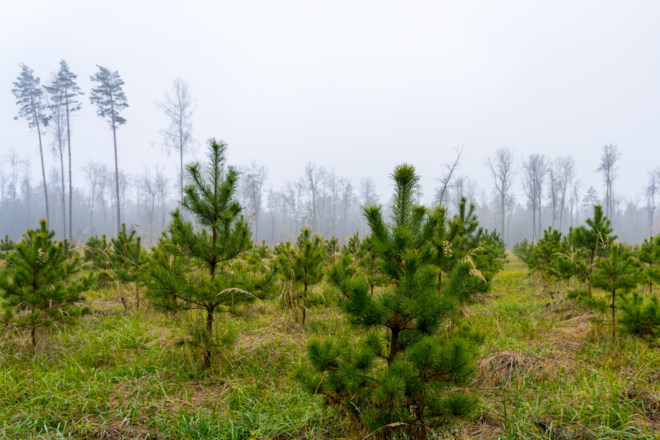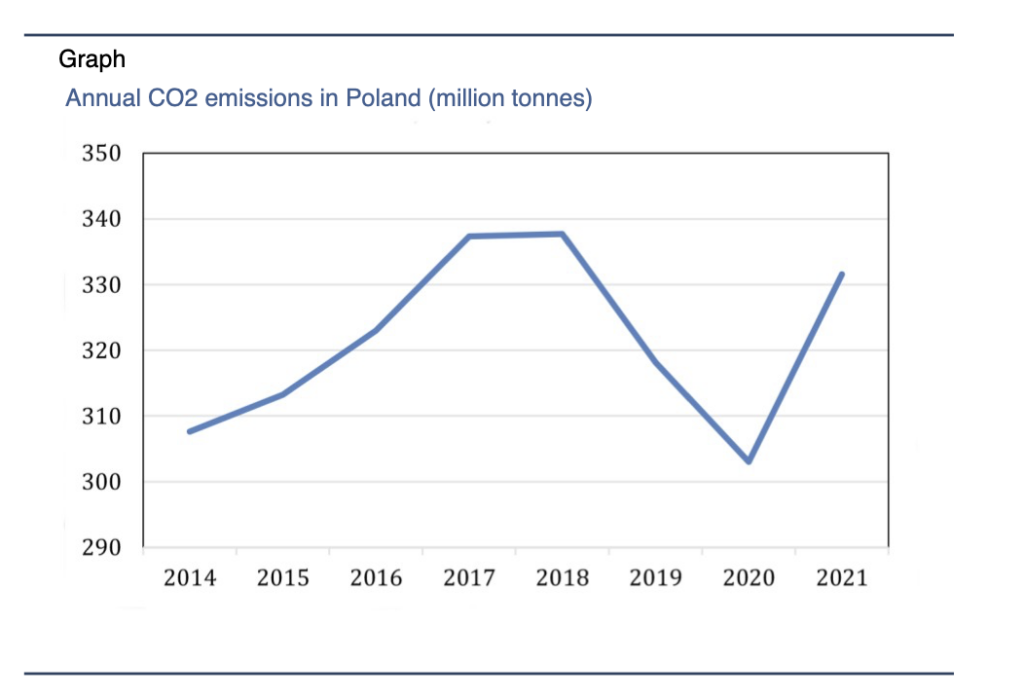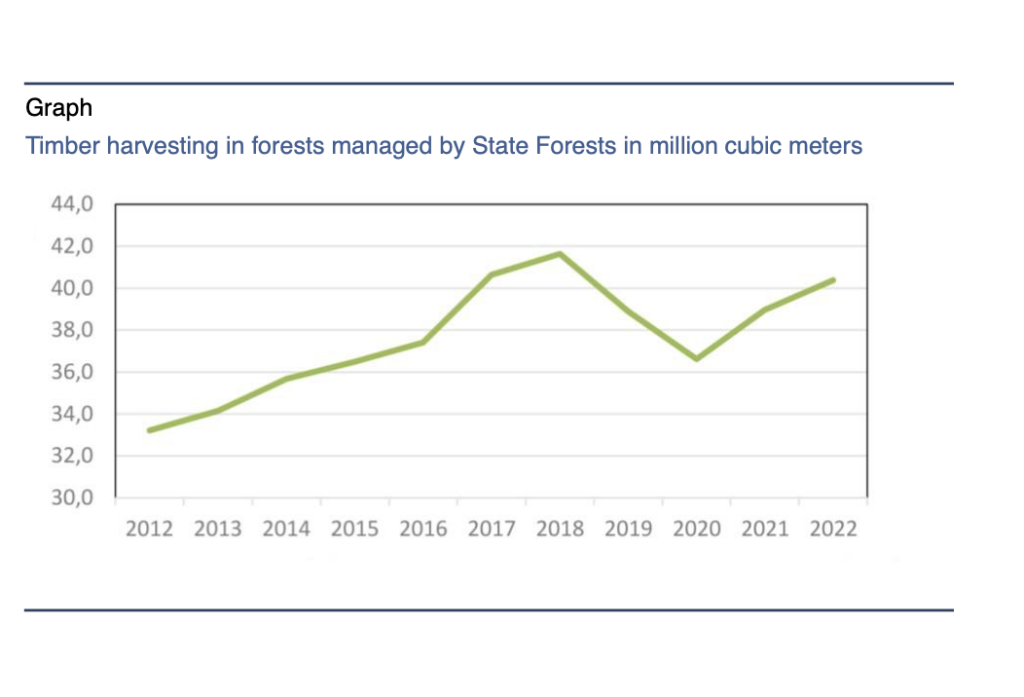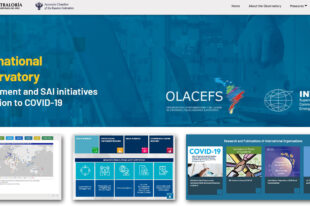Greenwashing State Forest Harvesting in Poland

Author: Iwona Zubrzycka-Wasil Senior Public Auditor Supreme Audit Office of Poland
Introduction
The Supreme Audit Office of the Republic of Poland (NIK) audited the implementation of a strategic pilotage project, Forest carbon farms, to verify its performance and if funds were spent efficiently during its implementation by the General Directorate of State Forests. The audit also looked at whether it enabled obtaining the best outcomes, and if forest divisions correctly and reliably planned and performed their activities included in the project.
NIK audited activities of the Minister of Climate and Environment, the General Directorate of State Forests, and 12 out of 25 forest divisions that were implementing the pilotage, Forest carbon farms project (out of 429 total divisions in Poland). The audit covered the first phase of project implementation in the years 2017-2023.
The 2030 National Environmental Policy Development Strategy in the Area of the Environment and Water Management adopted in 2019, among others, provided for climate change mitigation through effective reduction of the greenhouse gas (GHG) concentrations in the atmosphere, carbon dioxide concentration reduction and sequestering carbon by forests through further implementation of the project, Forest carbon farms, which started in 2017.
Solutions and technologies aimed at carbon dioxide absorption are one of many climate change mitigation activities. Forests play a crucial role in natural carbon dioxide (CO²) absorption from the atmosphere. In 2021, in Poland forests absorbed a total of 22,2 million tonnes of CO², accounting for almost 7 % of total national emissions and the value corresponded with the average EU indicator in 2019.

Activities undertaken in the selected 23 forest districts were supposed to contribute to the increase of CO² absorbed by forest ecosystems.
Forest Carbon Farms Project Activities and Expected Outcomes
The assumption of the project was to initiate its performance in the years 2017-2026 including activities additional to regular forest management. These additional activities include: increasing space of selected areas with underplanting and understory, use of additional seedlings, and reforestation by natural seeding. The remaining additional activities were aimed at capturing additional amounts of organic carbon in selected forest districts or progressive storage of cumulative carbon in the raw wood stored in woodyards for energetic purposes.
Initially, the project was intended to create a network of such woodyards in state managed forests to store huge amounts of raw wood, which remained after extreme weather events such as winds or hurricanes, more frequent due to climate change. However, NIK stated that none of the post hurricane woodyards were created and, as a result of changes regarding timber turnover regulations, the idea was abandoned.
It was also assumed that the experimental introduction of a national system of domestic CO² emissions trading certificates into the market as a result of additional activities in forestry, could allow the entities included in the European Union (EU) Emissions Trading System (ETS) to purchase units of captured emissions in the years 2017-2020, which would then allow them to meet emission reduction targets resulting from the EU climate regulations. However, the idea has not gained interest neither from the EU policy makers nor from the entities, and was discontinued. Also, no legal basis for this alternative to the EU ETS was ever created.
State Forests’ regulation on Forest carbon farms was modified and differently defined as “additional activities”. These additional activities were described as forest management activities that overlapped with standard procedures adopted in the given locations, and the circumstances or activities that were not covered by the binding forests management plan, but aimed to capturing additional amounts of CO² along the prognosed implementation phase.
Additionally, the purposes of the additional activities of the Forest carbon farms project were modified by obtaining additional amounts of biomass possible for acquisition for future sale and supply. This was intended to store additional amounts of carbon and reduce greenhouse gases emissions, including carbon dioxide.
NIK Assessment and Findings of the Forest Carbon Farms Project
NIK found that the two above project purposes were contradictory. The assumption that biomass, including trees planted to absorb CO² was to be removed later, means that it should be expected that this would result in a reduction in CO² absorption, which may reset the activities taken to store additional amounts of organic carbon in this biomass.
Moreover, since the utility value of trees planted in this project would be lower than that of trees planted as a result of the standard forests’ management. Supposedly, the wood would not be intended for the production of furniture or other wood products, but used as fuel for energetic purposes. This would quickly result in significant increase of CO² emissions stored in these trees for many years.
According to the NIK audit results, the outcome of Forest carbon farms and its continuation: the development project called Carbon Forest, had no real impact on the increase of CO² emission reductions. Annual national average CO² emissions were approximately 325,6 million tonnes, while the basic project outcome was only 1,006 million ton of CO². Accordingly with later prognosis revaluations, in April 2023 , it had dropped to 0,929 million tonnes of CO².
The prognosed outcome of the project planned for a 30 year implementation (2017-2046) was an additional value of captured CO². The value was calculated by Forests Research Institute with the use of specialised software (Canadian model CBM-CFS3). For calculations, the services used databases which included: species, age, space of forests divisions, type of treatment, area of treatment, and growing stock curve.
Implementing the current research results into the determined algorithm resulted in a smaller than planned project outcome. The amount of additionally captured CO² calculated with the use of the above method would not have noticeable impact on national CO² emissions reduction. The assumed CO² compensation of approximately 0,031 million tonnes annually was more than a thousand times lower than emissions of just one power plant, Bełchatów, (38 million tonnes) and less than 0,1 per mile of total national CO² emissions in Poland, which was 331,6 million tonnes of CO² in 2021.
Tree Harvesting Increases in Forests Managed by Poland State Forests

At the same time, State Forests in every year of the project implementation increased tree harvesting. NIK found that the real purpose of the project was solely to improve the State Forests’ image through greenwashing forest cutting. This was to create the illusion that the company mitigated climate change, and to distract the public opinion from robbery deforestation.
NIK stated that a more efficient activity intended to reduce CO² emissions would be increasing forest areas and limiting tree harvesting, especially for biomass purposes, which could further reduce final CO² emissions.
NIK Audit Finds Shortfalls Due to Unreliable Planning and Supervision
Aside from greenwashing the image of State Forests and of the involved entities co-financing some project activities, it only marginally contributed to real solutions resulting from excessive CO² emissions in Poland.
The NIK audit revealed that in 2017–2023, Forests carbon farms research project expenditures of 65,5 million PLN (approx. 15 million euro) were used inefficiently. The results of the main objective of project implementation, increasing carbon dioxide absorption by forests, had insignificant impact on increasing the rate of CO² emission reduction.
Despite inefficiency of the first project, in 2022 the State Forests Director took a decision on its continuation in form of a second project, Carbon Forests, with planned expenses of 398,8 million PLN (approx. 93 million euro) to be covered from State Forests own funds.
The activities carried out were, on the one hand, supposed to lead to storage of additional amounts of organic carbon in forests for CO² absorption. On the other hand, this stored forestry was to be used to obtain additional biomass that could be obtained and sold, which, if used for energy purposes, would result in the emission of previously absorbed CO².
Project Forest carbon farms was improperly prepared: expected expenses that would be incurred for its implementation were not specified. In 2023, during the NIK’s audit, the expenses were estimated at PLN 78.6 million.
The missing financial plan of the Project was not conducive for the effective use of funds. The Project had limitations in the ability to effectively control expenses and focus them on achieving the main objective of the Project: the increase in the amount of CO² absorbed by the forest ecosystem.
The Minister responsible for the environment did not exercise reliable supervision over the planning and implementation of the Forest carbon farms project. He did not ensure sufficient influence on the preparation and implementation of the project by the Director General of the State Forests. According to the strategy of responsible development in Poland, the Ministry of the Environment was responsible for its preparation and implementation, and the Minister was responsible for supervising the State Forests and forest management in the divisions where the Project was implemented.
The Minister did not undertake any activity to obtain a reliably estimated budget of the project from the Director General of the State Forests, which limited his ability to supervise expenditures intended for its implementation.
The Minister’s supervision over State Forests during the project implementation was insufficient and limited to accepting only periodic reports. The reports did not have sufficiently thorough analysis of the data, which, as NIK’s audit proved, turned out to be unreliable.
In the area of nearly one third of all forest divisions included in the Carbon Farms project conducted activities that did not contribute to achieving the main purpose of the project, which was increasing the amount of CO² absorbed by the forest ecosystem. The forecasted additional amount of CO² to be absorbed over 30 years was either a negative value or equal to zero. This meant that their implementation in these divisions resulted in less CO² absorption compared to regular activities without the project implementation (when reductions would be higher), or it could not produce any positive additional effect of carbon dioxide absorption.
Information contained in periodic progress reports in 2019–2023 submitted by the State Forests Director General to the Minister of Climate and Environment were not consistent with the actual situation for the amount of incurred costs, the degree of implementation of individual activities, as well as the achieved results. State Forests monitored the project’s progress in an unreliable manner, and some reporting documents were prepared only during the NIK audit, including State Forests internal regulations specifying the assumptions and implementation rules.
The forest districts participating in the project performed their tasks in accordance with the adopted assumptions, prudently using allocated funds. By the end of 2022, they carried out activities in approximately 76% of the area covered by the project in 2017–2024.
Initially, forest divisions carried out their activities only on the basis of arrangements with the State Forests Director General, without information on their projected impact on the environment, including the amount of CO2 absorption, because the application enabling development of individual tasks under the Project was made available to forest districts only in September 2018.
However, in more than half of the forest districts, cases of late submission of annual progress reports were found, as well as cases of unreliable reporting of data, including understatements of incurred costs.
Conclusions
Taking into account overall responsibility for the project supervision assigned to Minister of Climate and Environment regarding its preparation and implementation, as well as the to the State Forests Director General for its performance, NIK recommended to suspend the implementation of Carbon Forests project, until the completion of the pilot research project, Carbon forest farms, and summarization of achieved results. NIK also recommended the Minister of Climate and Environment to conduct a thorough analysis of Carbon Forests project justification, taking into regard the prognosed weak results of the Carbon forest farms project.
For additional information, please visit: https://www.nik.gov.pl/aktualnosci/lesne-gospodarstwa-weglowe.html





